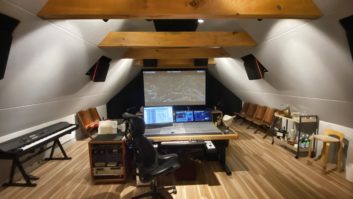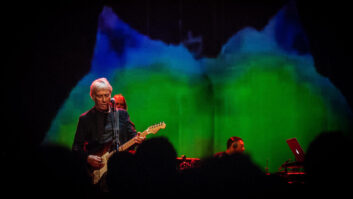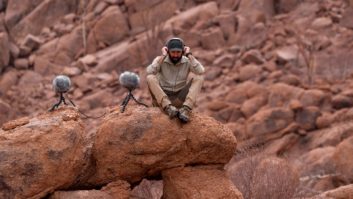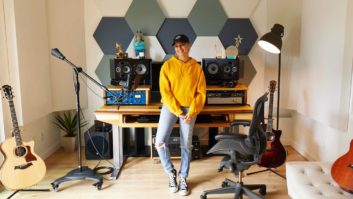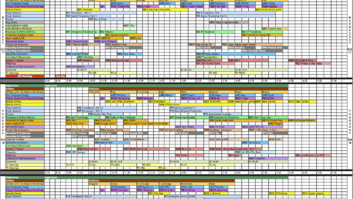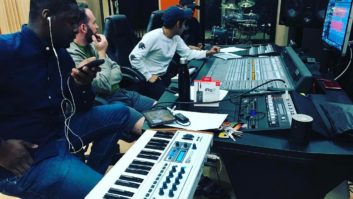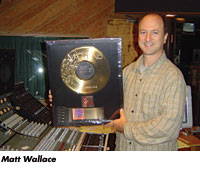
By definition, a music producer is responsible for getting the jobdone. Ensuring that happens is a process that can encompass anythingfrom creating a proper vibe to complete track construction andeverything in between: managing the budget, choosing songs andmusicians, creating musical arrangements, providing psychotherapy andgeneral handholding — you name it. Every project is different,and every producer has a different set of skills. But for many years,for any project, at least one thing was pretty much taken for granted:The record was going to be made in a commercial recording studio. For awhole generation of producers and engineers who grew up nurtured by theold-school recording studio culture, that was a simple fact oflife.
These days, of course, things are different. Driven by technologyand changes in the business climate, the recording landscape has beencracked wide open. The excesses of the ’80s and ’90s are long gone, andstudios can no longer afford the endless cycle of “bigger, betterand more.” Home studios compete with the big boys and all kindsof people are looking for new careers. Meanwhile, producers determinedto stay in the game are adapting and getting creative about how andwhere they record.
Producers are redefining how the job gets done and carving out aliving doing what they love and are good at. Here, Mix checks inwith a few stalwarts for some insights into the challenges of makingrecords now.

PRIVATE ANDSELF-CONTAINED
A number of people recording today avow that a commercial studio iscompletely unnecessary. Producer/mixer Scott Humphrey, known for hiswork with Rob Zombie, Monster Magnet and Ozzy Osbourne, among others,is one of them.
“The business is definitely changing,” he says, speakingon the phone from the elaborate studio that he’s constructed in a housein the Hollywood Hills, “but I changed my style of working longago. I moved into my own space permanently about eight years ago,because I wanted the convenience of always having things set up the wayI want them.”
Humphrey’s studio takes up the whole 7,200-square-foot house. Thecontrol room, equipped with a 64-input SSL G Plus, is larger thanyou’ll find in many commercial studios. Nearby, dedicated drum andguitar recording spaces are outfitted with everything a rocker needs tosound huge.
Humphrey owns the building that houses the studio, but he chooses tolive 45 minutes away. “It’s too hard to unwind at the end of theday if you’re living in the same place you’re working,” hecomments. “Sometimes, though, it can be an advantage to staythere. I’ve gone through periods where I slept at the studio and mixedin the middle of the night. That can work out great, because 90 percentof the time, when you’re mixing, you don’t really need anyone elsearound.”
After starting out as a musician, Humphrey progressed to productionand then added engineering to his skill set. He notes that, these days,the line between who’s doing what technical job tends to blur dependingon the session: The producer is, at any given moment, the engineer andperhaps the Pro Tools operator. “I don’t necessarily want to doall of the jobs, but I’m usually doing two of the three. Engineeringcame with producing. You can’t really know how to do one without theother. But there’s more expected of you now. You have to be able towear as many hats as possible. Pro Tools used to be a specialized area.Now, it’s just a requisite skill to get to the next level. Sometimesyou can’t afford to have a guitar tech, a drum tech, an assistantengineer and an engineer. You may have to take on some of those rolesyourself. Even if you don’t, you have to know how to dothem.”
Staying in one place for a whole project works well for Humphrey,because, stylistically, he tends to dispense with separatepre-production. Instead, he prefers that bands learn the songs to berecorded while in the studio, moving immediately to recording whileeverything is fresh.
The social aspects often touted as a plus to recording at acommercial studio complex also find no favor with Humphrey, who citesthe benefits of a private facility where he doesn’t have to deal with“people constantly coming in to visit.” He admits, however,that building and maintaining the kind of high-end studio he owns isn’teasy, noting, “It’s a long-term commitment to add to yourcollection of equipment as you can afford to, until you reach the pointwhere you’re really happy and you have everything you need.”
THE INCREDIBLE SHRINKING STUDIO
Composer/producer Pete Scaturro also says that he has no need to usea commercial studio. Currently, he’s even downsizing the physical spaceof his own Venice, Calif., live/work studio compound. Scaturro beganhis career as a musician and producer of alternative rock bands in theSan Francisco Bay Area. Although he long ago transitioned intosound-for-picture — that’s his theme music you hear on ABC’sThe Practice — until recently, he kept his hand inproducing records for the likes of virtuoso guitarist Buckethead.Lately, he’s making changes in direction.
“Big-album budgets, except for really major artists, have goneaway,” he states. “And the mid-level record has all butvanished. Since my experiences with labels in the past were oftennegative, I don’t think it’s all that much of a loss. I really believethat with the importance of visuals growing, it doesn’t make much senseto work on anything that doesn’t include them.”
As far as working style, Scaturro continues, “My studio hasdefinitely shrunk and my job description has changed. In the past, Ididn’t have to do so much engineering; I’d leave that job to someoneelse. Now, I do everything from making backups to labeling tapes— it’s become a one-man show. With budgets reduced, it’s muchmore profitable if I don’t have to hire other people.”
Scaturro’s studio used to include a big live room and clientamenities, but, because he’s using fewer musicians and taking advantageof FTP uploading for project review and approval, those things are nolonger necessary. “I have fewer and fewer people coming down tothe studio,” he asserts. “I used to have a big live roomand a pretty big control room. Now, I’m going to basically just occupyhalf of the building. In constructing my new studio, I’m not reallythinking about the clients, who were my first concern in thepast!”
Another change Scaturro sees is in people’s expectations of howprojects can change. “In the past, when you cut tracks in a moretraditional studio, there was the big recording date,” he says.“Producers would come down to the session, and there was a senseof that day being important and that you weren’t going to change thingstoo much after the fact. Psychologically, it was a different way oflooking at things. Now, everything is — supposedly — easyto change.”
LOCATION, LOCATION, LOCATION
Of course, plenty of people are still recording bands in studios. Inmusician/producer Dave Fridmann’s case, the bands often make the trekto Tarbox Road, the residential upstate New York facility he co-ownswith his wife Mary and experimental pop rockers the Flaming Lips.
Fridmann, in addition to his production work with bands such asCafé Tacuba, The Delgados and Sparklehorse, has been a longtimecollaborator with both the Lips and the legendary Mercury Rev. Tarboxcame about, back in 1997, when he wearied of leaving home and family togo to work. “By the early ’90s, it had become pretty much up tome to decide where to record most of the projects,” he recalls.“There was no place within 150 miles of here with facilities thatwere adequate for what I needed, so I’d just find the best, cheapeststudio I could and go there. It became obvious that I was bringingthose places ‘x’ amount of business per year, and that Icould build and make payments on a studio for less. Ultimately, it wasa matter of convenience and quality of life. We don’t really make moneywith the studio, but it is self-sufficient.”
Fridmann made a conscious decision to separate home and studio— by 10 miles. “I used to work at a studio where the ownerlived across the street,” he says with a laugh. “I’d callhim at 3 a.m. when I couldn’t find a mic, and he’d come over and helpme out. Now I realize how inappropriate that was, but I also knowpeople would do to that to me if I lived across the street!”
Those who use residential studios often tout the camaraderie createdduring the recording process. Fridmann agrees that the“cloistered environment” can foster creativity. “In aplace that doesn’t have a 9-to-5 mentality,” he observes,“musicians can be really relaxed. At the same time, they canreally concentrate.”
No 9-to-5 can mean 24/7. Fridmann tries to keep to a 12-hour day,and encourages bandmembers to work on their own if they want to golonger. “Most musicians know Pro Tools now. Since it’snondestructive, I’ll save what I have, make a backup, set up the micsand let them go ahead. It can be good for them to feel no distancebetween themselves and the music and to spend all night if they want. Alot of musicians do their best work between 2 and 4 a.m.!”
On the occasions Fridmann leaves his hometown to work, he looks forstudios with a lot of gear options and a lot of space. “I want itto be an experience where everybody can spread out and be comfortable,and where the room sounds good. A lot of the great rooms goteliminated. But to me, it’s really the only point of going to a bigstudio anymore.”
When he’s not at Tarbox, which is equipped with an Otari Conceptdesk, Fridmann tends to choose 80 Series Neve consoles for mixing. But,due to the ubiquitousness of quality outboard preamps, he asserts thatthe actual recording console, at least for tracking, isn’t of hugeconsequence anymore. “You end up bringing in your own modules andcreating a hybrid recording setup that couldn’t possibly exist. Theconsole itself is just the playback conduit. With Pro Tools, if youhave a decent mic and a Neve module, you can record a lot of yourmaterial anywhere.
“What I see for the future,” he predicts, “is theartist continuing to gain control of the recording process. With a ProTools Mbox or Digi 002, you can do a very good product in your home.You can track drums and mix in a big studio, and overdub at home untilyou’re blue in the face with a good mic and preamp. As a producer,there’s a trust issue to having clients do that, but we’ll talk aboutit at length. A lot of times, I’ll literally set up the recording chainat my studio, write down all the parameters and send them home withit.
“I guess, to some degree I saw the writing on the wall withthe movement toward residential and other alternative studios. Bandstypically seem to like coming out here and being away fromdistractions. At first, the labels had some concern that we were so faraway from them, but over time, I’ve built up enough trust with them;we’ve quelled their fears.”
MAKING IT WORK
Matt Wallace is another musician/producer who’s made quality-of-lifechanges in his working style. Well-respected for a Platinum trackrecord that includes Faith No More, The Replacements, Blues Travelerand Train, among many others, Wallace is currently riding high withMaroon 5’s Songs About Jane, which, on the week we spoke, wasNumber 7 on the Billboard Hot 200.
Although some years ago he foreswore studio ownership, Wallace hascome around again; currently, he maintains a personal studio at theSound City complex in Van Nuys, Calif.
Wallace has worked with budgets both large and small. A couple ofyears ago, the decision to sign on for a spate of indie records gavehim a leg up on dealing with the challenges that are now prevalent ingetting records made. “The saving grace has been putting togethermy own studio,” he says. “Six years ago, I had one in theOcean Way complex. I loved the vibe and the creative aspects of havinga place set up and ready to go, but I didn’t like having to run afacility. Ultimately, I sold off most of the gear and went back toworking in commercial studios.”
Wallace’s manager, Frank McDonough, persuaded him to try again byemphasizing the benefits: Money spent at outside studios could bereapportioned to the project as a whole, helping to alleviate the timepressure demanded by today’s lower budgets. “When I had thestudio before, we opened it up to outside clients, leading to a lotmore complication,” Wallace explains. “The only time mycurrent studio works is if I’m there or if I let friends use it. I’veset up my gear in what was a rehearsal space, so it’s sort of like agiant living room. The lack of pressure is the best thing: If a band ishaving a bad day, they can go home and try again tomorrow. Also, I cantry to go home for a couple of hours every night for the kids’ bath andbedtime. It means more driving, but too many people in this businessonly see their kids on Sundays. That doesn’t work for me.”
For recent projects, Wallace tracked at other studios, includingSound City and Burbank, Calif.’s Third Stone, citing large live roomswith vintage consoles, iso booths and good headphone systems as thedraw.
A recording tactic Wallace now employs, for reasons of bothcreativity and efficiency, is making sure that at least two people atany given time are working. “I did a project a while back wherewe always had three Pro Tools rigs set up, so we could be doing vocals,guitars and cleanups all at once,” he comments. “It wasgreat for the budget, and it was also much more exciting. I hate itwhen the singer’s singing and the rest of the band is twiddling theirthumbs, watching the producer or engineer in front of the Pro Toolsscreen. This way, there’s a lot more excitement and enthusiasm.
“I rely on Pro Tools, like any other producer,” hecontinues. “But a lot of the fun has been missing since it tookover. These days, I always try to get the vibe of a bunch of musiciansin a room doing their thing, playing off of each other and havingmoments of brilliance. That’s what I’m looking for.”
THE BEST OF ALL WORLDS
Nashville-based producer/engineer Chuck Ainlay has, for many years,collaborated with singer/songwriter/guitarist Mark Knopfler onKnopfler’s recording projects. For the latest, they recorded at anumber of different places, including the residential Shangri LaStudios in Malibu, Calif., BackStage Studios in Nashville (in whichAinlay is a partner) and Knopfler’s home setup in England. Final mixingwas also scheduled to be done in England, the debut project atKnopfler’s elaborate new multiroom facility in London, which, when wespoke, was nearing completion.
With a budget that allows for a wide range of choices, how do youdecide where to work? “The sound of the room is always veryimportant to me,” says Ainlay. “For this project inparticular, we didn’t want to overdub lots of instruments to make itsound full and complete. We wanted the room sound to help fill in thespaces in the music. One of the reasons we chose Shangri La was itssonic space; the sound of the recording room was perfect for what wewere doing. We put most of the musicians in the same room and went forleakage, trying to get the ambience recorded on everybody as much aspossible.
“Also,” he continues, “although I do carry a lotof equipment with me, the microphones and outboard available at astudio matter a lot to me. Some of the songs we’re doing had a ’60s and’70s-ish vibe. Shangri La is a vintage kind of place with an old APIconsole, lots of great old outboard and an immaculate collection ofclassic ribbon and tube mics. I used Shangri La’s console for certainthings, but in general, rather than relying on a big board, I like tocreate a signal path for each mic that gives me the particular sound Iwant. The console is mostly a monitor playback desk.”
Ainlay suggests that the relaxed ambience of the Malibu studioaffected the music; the on-site living accommodations were also a plus.“We wanted a place where everybody could have their own space,but also hang out and feel like we were a group,” he comments.“It definitely helped with the energy of the record to be in sucha beautiful place. There were a lot of remarks about how it didn’t feellike we were working, and I think that’s part of the reason we ended upgetting so many first takes. The ambience drew out some wonderfulperformances.”
With basic tracks complete, a stop was made in Nashville to addparts by local musicians. Then it was off to work at Knopfler’s Londonhome workspace, which he and Ainlay both admit isn’t really a studio,just “a living room and bedroom where we do guitar and vocaloverdubs and comps.”
Knopfler’s new facility, on the other hand, is indeedstate-of-the-art for both new and vintage equipment. The Neve 88Rstudio, with iso rooms, variable acoustics and a tracking space largeenough to house a large orchestra, is also equipped with Beatles-eraEMI consoles. “I always wanted a space where a band could play inthe room together. All of my favorite recordings are done likethat,” says Knopfler.
The B room features an API desk. Both rooms, built with full-range5.1 monitoring, also have dual Studer A800 analog 16/24-trackrecorders, and Pro Tools and Nuendo systems. Wait a minute —isn’t building a studio like this flying in the face of all the othertrends we’ve been discussing here? “I’m always miles behindeverybody else,” Knopfler says with a laugh. “Anybody withany sense is closing their studio, and I’m just buildingone.”
Well, so much for trend analysis. What’s it all mean? These days,one size fits all doesn’t. Projects are being tailored to suit thebudget, the desired sound for the music and the band’s personality.Whatever the budget level, producers want the best they can afford fromboth old and new technology. Custom setups have, in large part, takenover, with the individual signal path most important in recording.There’s a desire for recording environments that feel relaxed, but are,in reality, highly productive.
It’s not about the latest and the greatest anymore, it’s about whatreally works and what will deliver the best results for the money. Eachproject takes more thought to work out what its individual requirementsare and where the budget is best spent. There’s still a strong need forgood-sounding live recording spaces and proper control rooms formixing, albeit at the right price. And contrary to how it may sometimesseem, there’s still a need, perhaps more than ever, for skilled andexperienced engineers and producers who know how to maximize a budgetand get the job done.
Maureen Droney is Mix’s Los Angeles editor.
